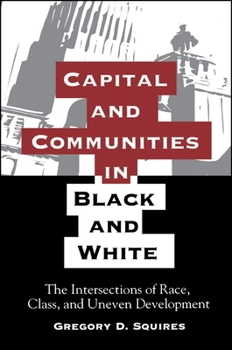Capital and Communities in Black and White: The Intersections of Race, Class, and Uneven Development
Select Format
Select Condition 
Book Overview
Capital and Communities in Black and White explores the problems created by global economic restructuring, the decline of inner city neighborhoods, and the heightened racial conflicts in the United States.
Format:Paperback
Language:English
ISBN:0791419886
ISBN13:9780791419885
Release Date:July 1994
Publisher:State University of New York Press
Length:185 Pages
Weight:0.70 lbs.
Dimensions:0.4" x 5.9" x 8.9"
Customer Reviews
2 ratings
interesting perspective of community development
Published by Thriftbooks.com User , 14 years ago
In 1968, the Kerner Report of the national Advisory Commission on Civil Disorder warned that the country was dividing into two distinct societies: poor inner cities with large black and minority populations and affluent suburban communities with mostly white populations. When Squires writes Capital and Communities in Black White 25 years later, this is no longer a warning, but a stark reality. According to Squires "...government policy and private sector activity through both planning and market forces have generally reflected those inequalities of race and class that have served as the principle dynamics shaping uneven development and social change in the United States." Squire focuses on how the practice of privatism and the alliance between the public and private sectors have stifled the American dream within the black community most notably seen in the deindustrialization of American cities, sub-standard housing solutions, redlining that prevents community reinvestment, and the relationship between urban redevelopment and the privatization of the city. The following is a synopsis of some the book's key themes: Privatism is one of the key factors that have negatively affected the African American community. As people want to improve their material wealth, they tend to rely on the free market as the best vehicle to do so. And as American citizens, one would expect the government to support our rights to pursue said vehicle, but racial discrimination often prevents the African American community from participating. Deindustrialization of American cities is a phenomenon which Squire refers to this as "white flight economy." The jobs that once supported inner city residents have moved to greener and essentially whiter pastures. Furthermore, the jobs that are being created within the city are typically for upper, level positions typically held by white workers. Thus there is a stagnate labor force without any options. Housing decisions are usually determined by the government and private sector. These "solutions" tend to create congested environments of despair in the name of progress. Squires reiterates the question of who is actually benefiting the most from these arrangements. Redlining is yet another situation where government aid is determined by private enterprises. In this case the private sector is deciding which moneys go where in terms of community reinvestment. Squires highlights examples of black entrepreneurs that can't get the loans necessary to establish businesses or invest in their communities. The privatization of the city is the final theme of the book. Squire expresses how the private sector has been dictating the role of the public sector in cities--again in the name of capitalism and progress. Their alleged efforts to redevelop the city and boost the local economy tends to yield uneven spatial developments that ultimately increases the chasm of unequal distribution of wealth within the city. Squire notes some fu
Two Thumbs Up.
Published by Thriftbooks.com User , 24 years ago
A great book for anyone interested in learning more about the manner in which uneven development had affected African Americans in cities. Housing, political economy and labor are discussed.






